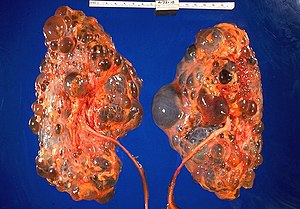Polycystic kidney disease
| Polycystic kidney disease | |
|---|---|
 |
|
| Polycystic kidneys | |
| Classification and external resources | |
| Specialty | Nephrology |
| ICD-10 | Q61 |
| ICD-9-CM | 753.1 |
| OMIM | 173900 |
| DiseasesDB | 10262 10280 |
| MedlinePlus | 000502 |
| eMedicine | med/1862 ped/1846 radio/68 radio/69 |
| Patient UK | Polycystic kidney disease |
| MeSH | D007690 |
Polycystic kidney disease (PKD or PCKD, also known as polycystic kidney syndrome) is a genetic disorder in which abnormal cysts develop and grow in the kidneys. Cystic disorders can express themselves at any point, infancy, childhood, or adulthood. The disease occurs in humans and some other animals. PKD is characterized by the presence of multiple cysts (hence, "polycystic") typically in both kidneys; however, 17% of cases initially present with observable disease in one kidney, with most cases progressing to bilateral disease in adulthood.
Polycystic kidney disease is one of the most common hereditary diseases in the United States, affecting more than 600,000 people. It is the cause of nearly 10% of all cases of end-stage renal disease and affects men, women, and all races equally.
Signs and symptoms include high blood pressure, headaches, abdominal pain, blood in the urine, and excessive urination. Other symptoms include pain in the back, and cyst formation (renal and other organs).
Polycystic kidney disease is a general term for the two types of PKD, each having their own pathology and causes. The two types of PKD are autosomal dominant polycystic kidney disease (ADPKD) and autosomal recessive polycystic kidney disease (ARPKD), which differ in their mode of genetic inheritance.
Autosomal dominant polycystic kidney disease (ADPKD) is the most common of all the inherited cystic kidney diseases with an incidence of 1:500 live births. Studies show that 10% of end-stage kidney disease (ESKD) patients being treated with dialysis in Europe and the U.S. were initially diagnosed and treated for ADPKD.
There are three genetic mutations in the PKD-1, PKD-2, and PKD3 gene with similar phenotypical presentations. Gene PKD1 is located on chromosome 16 and codes for a protein involved in regulation of cell cycle and intracellular calcium transport in epithelial cells, and is responsible for 85% of the cases of ADPKD. A group of voltage-linked calcium channels are coded for by PKD2 on chromosome 4. PKD3 recently appeared in research papers as a postulated third gene. Fewer than 10% of cases of ADPKD appear in non-ADPKD families. Cyst formation begins in utero from any point along the nephron, although fewer than 5% of nephrons are thought to be involved. As the cysts accumulate fluid, they enlarge, separate entirely from the nephron, compress the neighboring kidney parenchyma, and progressively compromise kidney function.
...
Wikipedia
